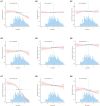Investigating how blood cadmium levels influence cardiovascular health scores across sexes and dose responses
- PMID: 39234072
- PMCID: PMC11371710
- DOI: 10.3389/fpubh.2024.1427905
Investigating how blood cadmium levels influence cardiovascular health scores across sexes and dose responses
Abstract
Background: The association between exposure to cadmium (Cd) and cardiovascular health (CVH) has received considerable scientific interest. However, findings thus far have been inconclusive, particularly regarding sex-specific effects and dose-response relationships. The aim of our study was to investigate the relationships of blood Cd levels with the overall and component CVH scores.
Methods: We used data from the 2011-2018 NHANES to assess CVH using indicators such as BMI, blood pressure, lipid profiles, glucose levels, diet, physical activity, nicotine use, and sleep quality, each rated on a 0-100 scale. The overall CVH score was calculated as the average of these indicators. We employed both multiple linear and restricted cubic spline analyses to examine the relationship between blood Cd levels and CVH scores, including nonlinear patterns and subgroup-specific effects.
Results: Our analysis revealed that higher blood Cd levels were associated with lower overall CVH, nicotine exposure, sleep, and diet scores, with nonlinear decreases observed in overall CVH and nicotine exposure scores at specific thresholds (-1.447 and -1.752 log μg/dL, respectively). Notably, sex differences were evident; females experienced more adverse effects of Cd on CVH and lipid scores, while in males, Cd exposure was positively correlated with BMI, a link not observed in females.
Conclusion: Our study highlights the complex interplay between blood Cd levels and various aspects of CVH, revealing significant dose-response relationships and sex disparities. These findings enhance our understanding of the biobehavioral mechanisms linking Cd exposure to cardiovascular risk.
Keywords: NHANES; cadmium; cardiovascular health; risk factors; sex factors.
Copyright © 2024 Chen, Lin, Zhang, Zhang and Chen.
Conflict of interest statement
The authors declare that the research was conducted in the absence of any commercial or financial relationships that could be construed as a potential conflict of interest.
Figures



Similar articles
-
Association of the American Heart Association's new "Life's Essential 8" with all-cause and cardiovascular disease-specific mortality: prospective cohort study.BMC Med. 2023 Mar 29;21(1):116. doi: 10.1186/s12916-023-02824-8. BMC Med. 2023. PMID: 36978123 Free PMC article.
-
Sex differences in Life's Essential Eight and its Association with mortality among US adults without known cardiovascular disease.Am J Prev Cardiol. 2024 Jun 3;18:100685. doi: 10.1016/j.ajpc.2024.100685. eCollection 2024 Jun. Am J Prev Cardiol. 2024. PMID: 38939696 Free PMC article.
-
Association between Life's Essential 8 and cognitive function among older adults in the United States.Sci Rep. 2024 Aug 26;14(1):19773. doi: 10.1038/s41598-024-70112-3. Sci Rep. 2024. PMID: 39187530 Free PMC article.
-
Association between cardiovascular health and all-cause mortality risk in patients with osteoarthritis.BMC Musculoskelet Disord. 2024 Aug 14;25(1):641. doi: 10.1186/s12891-024-07729-y. BMC Musculoskelet Disord. 2024. PMID: 39143482 Free PMC article.
-
Dietary glycation compounds - implications for human health.Crit Rev Toxicol. 2024 Sep;54(8):485-617. doi: 10.1080/10408444.2024.2362985. Epub 2024 Aug 16. Crit Rev Toxicol. 2024. PMID: 39150724
References
-
- Lloyd-Jones DM, Hong Y, Labarthe D, Mozaffarian D, Appel LJ, Van Horn L, et al. . Defining and setting national goals for cardiovascular health promotion and disease reduction: the American Heart Association's strategic impact goal through 2020 and beyond. Circulation. (2010) 121:586–613. doi: 10.1161/CIRCULATIONAHA.109.192703, PMID: - DOI - PubMed
MeSH terms
Substances
LinkOut - more resources
Full Text Sources

